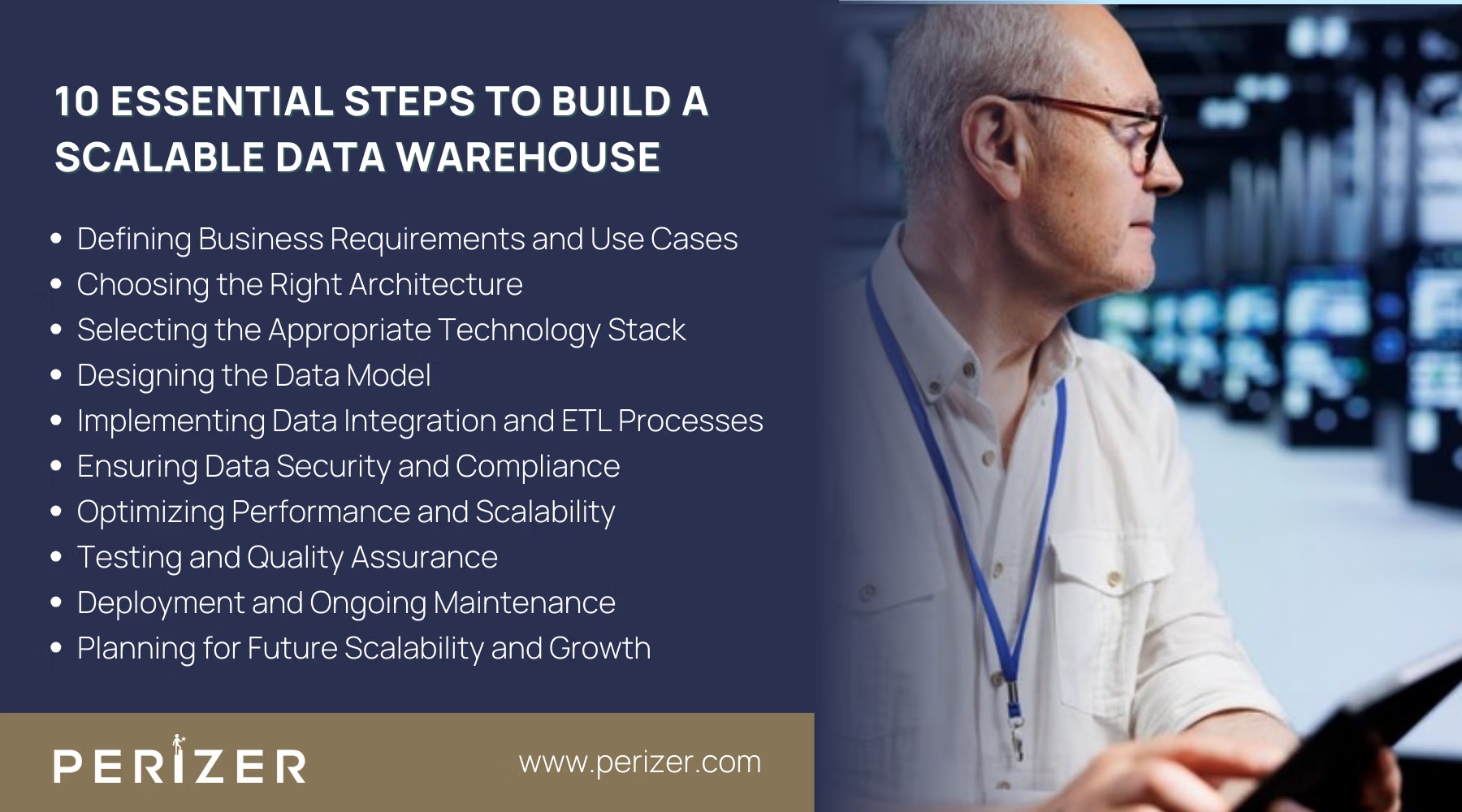10 Steps to Build a Scalable Data Warehouse for Future-Ready Insights
Learn 10 essential steps to build a scalable data warehouse that adapts to your growing business, ensuring efficiency, performance, and security.

A scalable data warehouse is a powerful system designed to store, manage, and analyze large volumes of data, allowing businesses to make the best-informed decisions based on comprehensive insights. Its importance cannot be overstated - it forms the foundation of any effective data strategy, enabling your organization to handle growing data volumes and increasingly complex queries as your business expands.
Building such a system requires careful planning and execution to ensure it is efficient, high-performing, and capable of supporting your business's long-term growth.
In this article, we highlight the advanced steps required to build a scalable data warehouse that not only meets your current needs but also grows with your business, providing a solid foundation for future success.
10 Essential Steps To Build a Scalable Data Ware House

1. Defining Business Requirements and Use Cases
Before you start building, it's important to deeply understand the business requirements and specific use cases your data warehouse needs to support. This stage is where you align the data warehouse's capabilities with your organization's strategic goals.
How to Define Your Requirements?
Start by gathering stakeholders from key departments like finance, marketing, sales, and operations. Engage them in detailed discussions about their current and future data needs. Instead of just asking them what reports they need, explore how they plan to use the data, what challenges they face with current reporting, and how often they need data refreshed. This will help you identify the types of analyses they require, the specific KPIs they track, and the level of granularity they need in their data.
Don’t forget to consider the look for growth in data volume. If your business is on a growth step, your data warehouse must be built to scale, so plan for higher data throughput and increased storage needs.
2. Choosing the Right Architecture
The architecture you choose for your data warehouse is like the foundation of a building; it needs to be solid and built to support whatever comes next. The right architecture can make the difference between a system that handles everything you throw at it and one that struggles under pressure.
How to Choose the Right Architecture?
Start by evaluating the complexity of your data and expecting how it will grow. If your operation is relatively small and your data needs are straightforward, a two-tier architecture that combines data storage and processing might be sufficient. However, if you’re managing large datasets from multiple sources and need to support complex queries, a three-tier architecture will serve you better. This setup separates data storage, processing, and presentation layers, offering greater flexibility and scalability.
For most businesses, cloud-based solutions are the best choice for scalability. Platforms like Amazon Redshift, Google BigQuery, and Snowflake allow you to scale resources easily as your data needs increase. These platforms also come with advanced features such as automatic partitioning and data replication, which improve performance and reliability.
If your business handles a significant amount of unstructured data, you might also consider integrating a data lake with your data warehouse. This allows you to store large volumes of raw data, which can be processed and analyzed as needed, giving you more flexibility in how you manage your data.
3. Selecting the Appropriate Technology Stack
Your technology stack is the foundation of your data warehouse. It’s not just about picking the most popular tools; it’s about selecting the ones that will work best for your specific needs and ensuring they all play nicely together.
How to Select the Right Technology Stack?
To start, focus on choosing the right Database Management System (DBMS). If you need to manage large volumes of structured data and perform complex analytical queries, traditional systems like Oracle or SQL Server can be a good fit. However, if your business requires a system that can quickly scale and handle a variety of data types, a cloud-native solution like Snowflake is more appropriate. Snowflake offers automatic scaling and data recovery features, which are ideal for businesses dealing with large datasets and needing fast, reliable processing.
Once you’ve selected your DBMS, turn your attention to data integration by choosing the right ETL (Extract, Transform, Load) tools. If your data comes in various formats and requires complex transformations, tools like Talend or Informatica are excellent options. For real-time data processing, consider Apache Kafka for streaming data and AWS Glue for efficient data processing and integration.
Finally, select Business Intelligence (BI) tools that align with your data warehouse’s capabilities. Whether you choose Tableau, Power BI, or another solution, ensure that it can handle the scale and complexity of your data. The goal is to have BI tools that provide real-time insights without burdening your system.
4. Designing the Data Model
Your data model is the framework that organizes your data warehouse. A well-designed data model ensures your system runs smoothly and scales with your growing data needs.
How to Design an Efficient Data Model?
Begin by developing a conceptual model that reflects your business processes. Identify the core entities, such as sales, customer data, and inventory, and define how they interact. This foundational step ensures that your data warehouse is aligned with your business goals.
Then, define the logical design by detailing the tables, columns, and relationships within your data. Aim for normalization to reduce redundancy and maintain data integrity, but strike a balance to avoid overly complex queries that can slow down performance. In cases where certain data is accessed frequently, it might be beneficial to denormalize parts of the model to enhance speed.
In the physical design phase, adapt the logical model to suit the specific requirements of your chosen DBMS. For instance, if you’re using Snowflake, utilize features like automatic clustering to improve performance. On-premises systems may require manual optimization, such as indexing and partitioning, to ensure that queries remain efficient as data volumes increase
5. Implementing Data Integration and ETL Processes
Integrating data into your warehouse and transforming it to align with your data model is an important step. The ETL (Extract, Transform, Load) processes you set up are crucial for ensuring that your data warehouse operates efficiently and can scale as your needs grow. This phase is where all your planning comes together, directly impacting the performance and scalability of your system.
How to Implement Effective ETL Processes?
To start, identify your data sources and decide how frequently you need to extract data. If you need real-time updates, consider using Change Data Capture (CDC), which allows you to pull only the data that has changed since the last extraction. This approach reduces the load on your source systems and makes the ETL process faster.
During the transformation phase, prioritize data quality. This is where you clean, standardize, and enhance your data, applying any necessary business logic to make it useful. Implement strict validation rules to ensure that only clean, accurate data enters your warehouse. For example, if you’re aggregating sales data from different regions, this is where you would standardize currency conversions and adjust for time zone differences.
Finally, make the loading process scalable. For the initial load, use bulk loading techniques to minimize setup time. For ongoing operations, incremental loading where you only add new or updated records is more efficient and helps maintain system performance as your data grows. In cloud environments, leverage auto-scaling features to manage peak loads automatically, reducing the need for manual adjustments.
6. Ensuring Data Security and Compliance
As your data warehouse grows, protecting your data and ensuring compliance with industry regulations becomes increasingly important. If your data isn’t properly secured, you risk significant issues such as financial loss and damage to your reputation.
How to Secure Your Data Warehouse?
Start by setting up strong access controls. Use Role-Based Access Control (RBAC) to limit access to sensitive data based on each user's role, ensuring that only those who need the data can access it. For very sensitive information, consider using extra measures like encrypting specific data columns or masking data to protect it, while still allowing access where necessary.
Encryption is a must. Make sure all your data is encrypted both when it's stored and when it's being transmitted. While many cloud-based data warehouses come with built-in encryption, double-check to ensure they meet your security needs. Use strong encryption methods like AES-256 to protect your data from unauthorized access.
It's also important to regularly audit and monitor your data. Set up logging systems to track who accesses and changes the data, and use automated tools to detect any unusual activity. Regularly review these logs to spot and address potential issues early.
Finally, ensure your data warehouse complies with all relevant regulations. Work with your legal and compliance teams to set up data retention policies, anonymize or pseudonymize personal data, and manage data rights, like the right to be forgotten under GDPR.
7. Optimizing Performance and Scalability
As your data warehouse grows, even a well-designed system can face challenges. To ensure it continues to run smoothly and efficiently, ongoing optimization is important.
How to Optimize for Performance and Scalability?
To keep your data warehouse running smoothly as it grows, start by improving your indexing strategy. Indexes can greatly speed up queries, but they also take up storage and require maintenance. Look at your query patterns to create indexes that offer the most benefits with the least cost. For instance, using partial or filtered indexes can boost performance for frequently accessed data without the need for full indexing.
Dividing your data is another effective strategy, especially for large datasets. By dividing your data into partitions, you can reduce query times and manage your data more efficiently. Choose a partitioning method that fits your query patterns, like range partitioning by date or list partitioning by region.
Regularly review and refine your SQL queries to keep them optimized. Complex joins, subqueries and unoptimized logic can slow down your system. Consider using materialized views to store the results of resource-heavy queries, and explore query supply if your DBMS supports it. Tuning your queries should be a regular part of your maintenance routine.
8. Testing and Quality Assurance
Before your data warehouse goes live, strict testing is essential. This phase is where you ensure everything functions as expected, from data integration processes to query performance. Neglecting this step can lead to costly errors down the line, especially when dealing with large, complex datasets.
How to Conduct Effective Testing?
Start with unit testing, where you check that each part of your data warehouse such as ETL processes, data transformations, and database schemas works correctly. For instance, make sure that the ETL process properly extracts, transforms, and loads data as expected. Identifying any issues early prevents bigger problems later.
Next, move to integration testing. This step ensures that all parts of your data warehouse, like the DBMS, ETL tools, and BI tools, work well together. For example, test how smoothly your BI tools pull real-time data from the warehouse for reporting. It’s important to confirm that data flows correctly from the source to the final reports.
Performance testing is also key. Check how your data warehouse handles large amounts of data and multiple queries at the same time. Simulate busy periods to ensure the system stays fast and doesn’t slow down or crash. If you’re using a cloud-based warehouse, test its ability to automatically scale up resources during peak times.
Finally, conduct User Acceptance Testing (UAT) by involving the end-users who will use the data warehouse daily. Their input is valuable because they can spot issues that might not be obvious during technical testing, such as data discrepancies or report layout improvements.
9. Deployment and Ongoing Maintenance
Deploying your data warehouse is a significant milestone, but it’s just the beginning of an ongoing process. To keep your data warehouse running smoothly and efficiently, you need to plan for continuous maintenance and updates.
How to Deploy and Maintain Your Data Warehouse?
Start by rolling out your data warehouse in phases rather than launching everything at once. Begin with a small group of users or a specific set of data. This step-by-step approach helps you spot and fix any issues early, giving your team time to get comfortable with the new system while minimizing disruptions to daily operations.
After deployment, set up a solid backup and recovery plan. Regularly back up your data to protect against potential losses. If you’re using a cloud-based system, use features like snapshots and point-in-time recovery to quickly restore your data if something goes wrong. Make sure your recovery processes are well-documented and tested so you can act quickly in case of an emergency.
Ongoing performance monitoring is also important. Keep track of how your data warehouse is performing, especially as data volumes increase and usage patterns shift. Use monitoring tools to identify slow queries, bottlenecks, or other issues that could affect performance, and regularly fine-tune your system to address these problems before they impact users.
Finally, regular updates and maintenance are key to keeping your data warehouse running smoothly. As your business grows, so will your data needs. Keep your system up to date with the latest patches, updates, and improvements. This might include upgrading your DBMS, adding new data sources, or adjusting your ETL processes to handle changes in your data environment.
10. Planning for Future Scalability and Growth
The best data warehouses are designed with the future in mind. As your business expands, your data warehouse should be able to grow alongside it, managing larger volumes of data and more complex queries without any issues.
How to Plan for Future Scalability?
Regularly check your data warehouse’s performance and capacity. Set up alerts to warn you when you’re nearing critical limits in storage, processing power, or query performance. By monitoring these areas, you can scale your infrastructure before problems arise.
Consider using modular architectures that allow you to add new components or upgrade existing ones without needing to overhaul the entire system. For example, you might start with a basic ETL tool and later add more advanced data integration platforms as your needs grow. This approach keeps your data warehouse flexible and adaptable over time.
Stay updated on emerging technologies and trends in data warehousing. As data management evolves, new tools and methods will emerge that can provide significant benefits. Keep an eye on advancements in artificial intelligence, machine learning, and real-time analytics, and think about how they can be integrated into your data warehouse to promote its capabilities.
Conclusion
Building a scalable data warehouse is a significant undertaking, but by following these steps, you’ll create a system that not only meets your current needs but also grows and adapts as your business evolves. From clearly defining your business requirements and selecting the right architecture to implement strong security measures and planning for future scalability, each step is vital to the success of your data warehouse.
Every step matters - whether it’s clearly defining your business needs, choosing the right architecture, implementing strong security, or planning for future scalability. These steps are all crucial to the success of your data warehouse.
FOCUSED, FAST, GOVERNMENT READY
Stay Tuned With Our Latest Insights

Staff Augmentation
Learn how to select the perfect IT outsourcing partner to promote your team’s capabilities, improve productivity, and drRead more...

Staff Augmentation
Find the perfect staff augmentation partner by aligning your goals, evaluating expertise, managing costs, and ensuring aRead more...

Cyber Security
We focus on understanding the needs, behaviors, and expectations of your users through extensive user research. This infRead more...